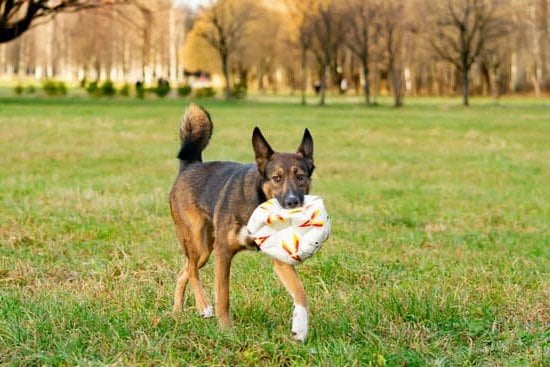Training a dog that can’t stop biting is not only essential for the safety of both the dog and its owner, but also for creating a harmonious relationship between them. Biting behavior in dogs should never be ignored or tolerated, as it can lead to serious consequences. In this article, we will delve into the reasons why some dogs exhibit continuous biting tendencies and explore effective training techniques to address this issue.
Addressing biting behavior in dogs is crucial because it can pose risks to the people around them. A dog that bites incessantly may cause harm to children, guests, or even strangers. Not only does this behavior jeopardize the safety of others, but it also puts the dog at risk of being labeled aggressive or potentially facing legal consequences. Therefore, it is imperative to understand the underlying causes behind a dog’s biting behavior and take appropriate measures to address it.
There are several reasons why a dog may exhibit excessive biting tendencies. It could be due to fear, anxiety, territorial aggression, resource guarding, or past traumatic experiences. By uncovering these potential triggers, we can gain insight into why a particular dog resorts to biting as their default response in certain situations. This understanding will enable us to design an effective training regimen tailored specifically for their needs.
In the following sections of this article, we will provide valuable information on setting safety measures for dealing with a biting dog and identifying underlying causes for biting behavior. Additionally, we will explore methods such as creating a consistent routine and structure, utilizing positive reinforcement techniques, and teaching bite inhibition. We will also discuss when professional help may be necessary and offer tips on maintaining patience and persistence throughout the training process.
By investing time and effort in understanding our furry companions’ behavioral issues and implementing appropriate training techniques, we can transform them into well-behaved members of our families. So let us embark on this journey together, as we explore effective ways to train a dog that can’t stop biting and create a safer, happier environment for both our furry friends and ourselves.
Setting the Ground Rules
When dealing with a dog that can’t stop biting, it is crucial to prioritize safety for both yourself and your furry companion. Bites can cause physical harm and be emotionally distressing, so taking necessary precautions is essential in creating a safe environment.
Firstly, it’s important to establish boundaries and create a designated safe space for your dog. This could be a gated area where your dog can feel secure without posing a risk to others.
Ensure that there are no items within reach that may trigger aggressive behavior or provide opportunities for your dog to bite, such as toys with small parts or chewable objects that resemble desirable items. Additionally, it may be helpful to invest in muzzles or gentle leader head collars that can prevent your dog from biting during potentially stressful situations, such as visits to the vet or encounters with unfamiliar people or animals.
In addition to physical safety measures, it is also crucial to educate yourself on proper handling techniques and body language cues of dogs. Understanding their behaviors will help you communicate with them effectively and respond appropriately before any biting occurs.
For example, recognizing signs of fear or anxiety in your dog allows you to modify their environment accordingly and prevent potential triggers. If necessary, seek guidance from professionals who specialize in canine behavior to gain insights into reading your dog’s body language accurately.
By implementing these safety measures, you are creating an atmosphere where both you and your dog can feel secure. It ensures the well-being of everyone involved while addressing the biting behavior. Remember, prevention is key when it comes to bites, so don’t hesitate to take necessary precautions before training begins in earnest.
Identifying the Underlying Causes for Biting Behavior
Biting behavior in dogs can be concerning and often requires addressing the underlying causes to effectively curb this behavior. By identifying the triggers and reasons behind a dog’s biting tendencies, owners can better understand their pet and develop appropriate strategies to address the issue.
One common trigger for biting behavior in dogs is fear or anxiety. Dogs may resort to biting as a defense mechanism when they feel threatened or overwhelmed. It is essential to identify the specific situations or stimuli that provoke fear or anxiety in your dog. This could include loud noises, unfamiliar environments, or interactions with other animals or people.
Past trauma can also contribute to a dog’s biting behavior. If a dog has had negative experiences in its past, such as abuse or neglect, it may display aggression as a result of those traumatic experiences. Understanding the potential impact of past trauma on your dog’s behavior can help you approach training and rehabilitation with empathy and care.
To properly identify the underlying causes for biting behavior in your dog, it is crucial to observe their body language and behavior patterns. Look for signs of stress or discomfort such as growling, lunging, raised hackles, or pinned ears. Take note of specific situations or triggers that seem to provoke these responses.
In order to effectively address these underlying causes, it may be beneficial to consult with a professional dog trainer or behaviorist who has experience working with aggressive behaviors in dogs. They can provide guidance on how to modify your approach based on your individual dog’s needs and help you navigate through any challenges that arise during the training process.
By understanding the underlying causes of your dog’s biting behavior and seeking professional guidance if necessary, you can take steps towards improving their overall well-being and creating a safer environment for both your dog and those around them.
| Common Causes of Biting Behavior | Signs/Symptoms |
|---|---|
| Fear or Anxiety | – Growling
|
| Past Trauma | – Aggression resulting from negative experiences or abuse in the past |
Creating a Consistent Routine and Structure
Establishing a consistent routine and structure is crucial when training a dog that can’t stop biting. Dogs thrive on consistency and predictability, and having a well-defined routine can help them understand what is expected of them and reduce their biting tendencies. Here are some guidelines to follow when creating a consistent routine for your dog:
- Set a Regular Feeding Schedule: Feed your dog at the same time every day to establish a predictable routine. This will not only help regulate your dog’s energy levels but also promote better behavior overall.
- Designate Regular Exercise Time: Dogs need regular physical exercise to release pent-up energy and prevent boredom, which can contribute to biting behavior. Create a schedule for daily walks, playtime, or other activities that allow your dog to burn off excess energy.
- Implement Basic Training Sessions: Incorporating short training sessions into your dog’s routine helps reinforce obedience commands and redirects their attention away from biting. Practice basic commands such as “sit,” “stay,” and “leave it,” rewarding good behavior with treats or praise.
- Provide Mental Stimulation: Dogs need mental stimulation just as much as physical exercise. Include activities like puzzle toys, obedience training with distractions, or scent work to keep your dog engaged and mentally stimulated.
By implementing these guidelines, you can create a structured environment that supports the reduction of biting behavior in your dog. Consistency is key in ensuring that your furry friend understands the rules of their environment and knows what behaviors are expected of them.
Table: Example Guidelines for Creating a Consistent Routine
| Guidelines | Description |
|---|---|
| Set a Regular Feeding Schedule | Feed your dog at the same time every day. |
| Designate Regular Exercise Time | Create a schedule for daily walks or playtime. |
| Implement Basic Training Sessions | Incorporate short training sessions into your routine. |
| Provide Mental Stimulation | Include activities like puzzle toys or obedience training with distractions. |
Remember, it may take some time for your dog to adjust to the new routine and understand what is expected of them. Be patient, consistent, and provide positive reinforcement when your dog exhibits good behavior. Over time, you will see a significant improvement in their biting tendencies as they become more accustomed to the structured routine you have created.
Positive Reinforcement Techniques
When training a dog that can’t stop biting, positive reinforcement techniques play a crucial role in promoting good behavior and discouraging biting tendencies. It is essential to remember that positive reinforcement focuses on rewarding desired behaviors rather than punishing negative ones. By using rewards and redirection effectively, you can help teach your dog alternative behaviors and encourage them to choose non-biting actions. Here are some helpful tips for incorporating positive reinforcement techniques into your training:
- Reward Good Behavior: When your dog exhibits appropriate behaviors such as gentle play or refraining from biting, it is essential to reward them immediately. Rewards can be in the form of treats, praise, or playtime with their favorite toy. The key is to make the reward meaningful and enjoyable for your dog.
- Redirect Negative Behaviors: Instead of scolding or punishing your dog when they show biting tendencies, redirect their attention towards an acceptable behavior. For example, if they start nibbling on your hand, quickly offer them a chew toy as an alternative option for satisfying their urge to bite.
- Consistency is Key: It is important to be consistent in your use of positive reinforcement techniques. Reinforce positive behaviors consistently every time you see them, so that your dog associates those actions with rewards and understands which behaviors are desirable.
- Use Clicker Training: Clicker training can be an effective technique for teaching dogs not to bite. The clicker serves as a marker signal that indicates when the desired behavior has been performed correctly. Pair the clicker sound with treats to reinforce positive non-biting behaviors.
- Patience and Perseverance: Training a dog to stop biting takes time, patience, and perseverance. Dogs may not learn new behaviors overnight, so it’s important to remain patient throughout the process and acknowledge small steps of progress.
Remember that each dog is unique, so it may require some trial and error to find the most effective positive reinforcement techniques for your dog. By consistently rewarding good behavior and redirecting negative biting tendencies, you can help to retrain your dog’s behavior and establish a harmonious relationship. Positive reinforcement not only helps to address biting but also strengthens the bond between you and your furry friend.
Teaching Bite Inhibition
Bite inhibition is a crucial skill for dogs to learn, especially for those that exhibit excessive biting behavior. It involves teaching a dog to control the force of their bites, reducing the potential for harm when interacting with humans or other animals. By teaching bite inhibition, you can help manage and modify your dog’s biting tendencies effectively.
One technique to teach bite inhibition is through redirection. When your dog starts to bite, gently remove your hand or any object they are biting on and replace it with an appropriate chew toy. This helps shift their biting focus onto something appropriate while also teaching them what is acceptable to chew on. Always praise and reward them when they redirect their biting behavior onto the chew toy.
Another effective method is using yelping or a high-pitched noise when your dog bites too hard. This mimics how dogs communicate with each other during playtime to indicate that a bite was too rough. By doing this consistently, you’re helping your dog understand that biting too hard results in negative consequences (i.e., stopping play), which encourages them to be more gentle with their bites.
Additionally, positive reinforcement training techniques can be employed when teaching bite inhibition. Rewarding your dog whenever they exhibit gentle play or refrain from biting too hard can encourage them to continue behaving appropriately. Consistently giving treats and praise during these moments will associate good behavior with positive outcomes in your dog’s mind.
Teaching bite inhibition may take time and patience, but it is an essential step in addressing a dog that can’t stop biting. Remember to be consistent in your approach and avoid any forms of punishment as they can exacerbate aggression issues. With consistent training efforts using redirection, vocal cues, and positive reinforcement techniques, you will gradually see improvements in your dog’s ability to control their biting tendencies.
Seeking Professional Help
Training a dog that can’t stop biting can be a challenging and complex task. While some dog owners may be able to successfully address biting behavior on their own, there are situations where professional help becomes necessary. In this section, we will discuss when it is appropriate to consult a dog trainer or behaviorist for assistance in dealing with persistent biting issues.
Signs that Professional Help is Needed
Knowing when to seek professional help is crucial in effectively addressing a dog’s biting behavior. There are several signs that indicate it may be time to reach out to a dog trainer or behaviorist.
One of the most prominent signs is when the biting behaviors persist despite consistent efforts in training and implementing various techniques. If your dog continues to exhibit aggressive behaviors and shows no signs of improvement over time, seeking professional guidance can help prevent any further escalation of the issue.
Another indication that professional help is needed is if the biting behavior poses serious safety risks. If your dog’s bites are severe and have resulted in injury to humans or other animals, it is imperative to consult an expert who can assess the situation and provide guidance on how to manage and modify the behavior effectively.
The Benefits of Consulting Experts
When dealing with a dog that can’t stop biting, enlisting the help of a professional can offer numerous benefits. Dog trainers and behaviorists have extensive knowledge and experience in understanding canine behavior, which allows them to accurately diagnose the underlying causes of biting tendencies. This expertise enables them to develop customized training plans tailored specifically to address your dog’s unique needs.
Additionally, professionals possess valuable skills in handling dogs with behavioral issues like excessive biting. They are equipped with effective techniques and tools designed to modify aggressive behaviors safely while promoting positive reinforcement methods. Moreover, working closely with a trainer or behaviorist provides you with ongoing support throughout the training process, allowing you to receive guidance and feedback to ensure consistent progress.
Patience and Persistence
Consistency is Key
When training a dog that can’t stop biting, it is crucial to approach the process with patience and persistence. Consistency is key in overcoming the challenges that may arise during training. Dogs thrive in a structured environment with clear rules and boundaries. Therefore, it is essential to establish and maintain consistency in your interactions with the dog.
Managing Setbacks
There may be setbacks or instances where your dog may exhibit biting behavior despite your efforts. It is important not to get discouraged during these times but instead stay patient and persistent. Understand that behavior change takes time, and setbacks are a normal part of the training process.
If you encounter a setback, take a step back and reassess the situation. Try to identify any possible triggers or underlying causes for the biting behavior that you may have missed. It might be helpful to consult with a professional dog trainer or behaviorist at this stage to gain additional insights and guidance specific to your dog’s needs.
Maintaining Motivation
Training a dog that can’t stop biting can be challenging, but staying motivated throughout the process is crucial for success. Celebrate each small milestone achieved by your dog as they gradually improve their behavior. Remember that progress happens gradually, so it’s important to keep encouraging your dog even when faced with setbacks.
Additionally, seeking support from other dog owners or attending obedience classes can provide a sense of community and motivation during this journey. Surrounding yourself with like-minded individuals who are also working on improving their dogs’ biting behavior can offer valuable insights, encouragement, and inspiration.
By approaching the training process with patience, consistency, and persistence, you will overcome challenges more effectively and ultimately help your dog develop better behaviors while curbing their biting tendencies.
Conclusion
In conclusion, training a dog that can’t stop biting requires patience, consistency, and dedication. By understanding the behavior of a biting dog and addressing the underlying causes, owners can create a safe environment and establish a consistent routine to curb biting tendencies. Positive reinforcement techniques and teaching bite inhibition are crucial in redirecting negative behaviors and rewarding good behavior.
It is important to recognize when professional help may be necessary for persistent biting issues. Dog trainers or behaviorists can provide expert guidance and support in overcoming challenging behaviors. Seeking their assistance can greatly contribute to the success of training and ensure the safety of both the dog and its owner.
Throughout the training process, it is essential to maintain patience and persistence. Setbacks may occur, but with determination and consistency, progress will be made. Training a dog to stop biting not only promotes a harmonious relationship between the owner and the pet but also ensures the safety of others who come into contact with the dog.
As owners witness their dog’s transformation from a biting companion to a well-behaved one, it is important to celebrate the progress made. Each milestone achieved should be acknowledged as an accomplishment for both the owner and the dog. With continued dedication, training efforts will ultimately result in a happy and well-behaved canine companion.
Frequently Asked Questions
Can you train a dog to never bite?
It is possible to train a dog to never bite, but it requires consistency, patience, and proper training techniques. Dogs typically bite as a response to fear, frustration, or discomfort. To prevent biting behavior, it is important to understand the root cause and address it accordingly.
A well-socialized and trained dog is less likely to resort to biting, so early socialization, positive reinforcement training methods, and teaching bite inhibition are crucial. It’s also essential for owners to set clear boundaries and provide appropriate outlets for their dog’s energy and instincts.
How do I get my dog to stop biting everywhere?
If your dog has a habit of biting everywhere, there are several steps you can take to address this behavior. First and foremost, it’s important to understand why the dog is biting. Is it out of playfulness? Fear? Aggression?
Once the underlying cause is determined, you can tailor your approach accordingly. Consistent training using positive reinforcement techniques can help teach your dog appropriate behaviors and redirect their attention away from biting. Providing plenty of mental stimulation through interactive toys or puzzle games can channel their energy in a positive way. Consulting with a professional dog trainer or behaviorist may also be helpful in developing an effective strategy.
Can you train an aggressive dog not to bite?
Training an aggressive dog not to bite requires specialized attention from professionals with experience in aggression management. Aggression in dogs can stem from various factors such as fear, territoriality, resource guarding, or learned behavior. Addressing aggression should always prioritize safety measures for both humans and other animals involved.
An aggressive dog requires careful management in terms of environment and interactions while implementing systematic desensitization and counterconditioning techniques under the guidance of a professional trainer or behaviorist. It is important to note that complete elimination of aggressive tendencies may not be possible in all cases; however, with diligent training efforts, many dogs show significant improvement in their behavior over time.

Welcome to the blog! I am a professional dog trainer and have been working with dogs for many years. In this blog, I will be discussing various topics related to dog training, including tips, tricks, and advice. I hope you find this information helpful and informative. Thanks for reading!





